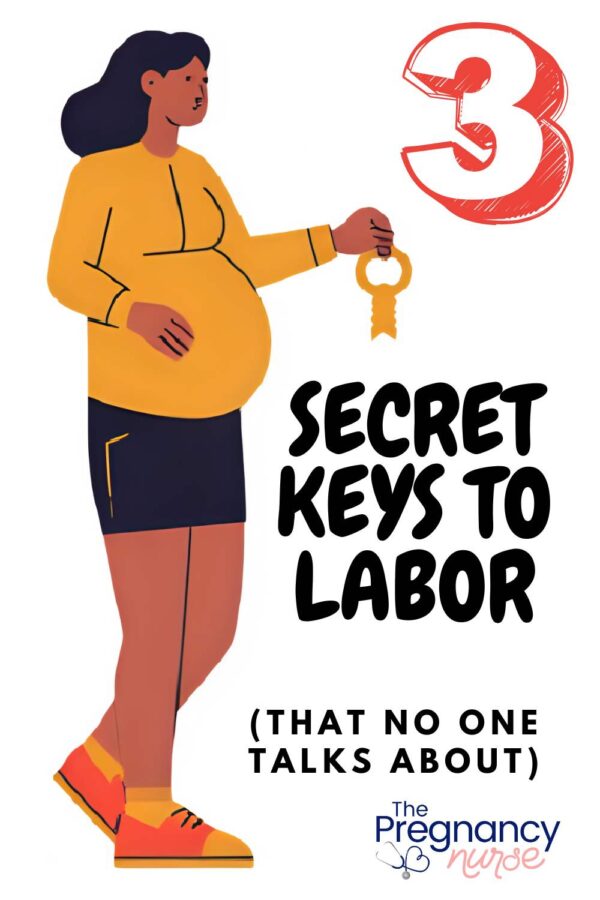There are a few keys to a great labor that no one really talks about (or talks about them right). Today I want to share them, when you can most effectively use them and also how to go about using them (because a few are trickier than you think). As a labor nurse for 20 years I’ve seen these used in just the right way to make labor so much better, and I hope I can help you do that too!

Of course, these are just some tips you can use — always talk about your situation with your provider so that you can make the best choice for yourself in the situation. As always, this isn’t medical advice, just some general tips for y’all. 🙂
You can go home.
I think there’s a song out there that says you can never go home — but it doesn’t apply to labor.
This one MAINLY applies to when an induction (or going in thinking you’re in labor only to find out that you’re not) just isn’t going anywhere.
And honestly, when I bring it up to patients you’d think that I was insane to even bring it up.
Let me just say that I know you left your house thinking — next time we come home, we’ll have a baby… but it may be better to wait a bit and then maybe something will happen or try again with an induction.
Now, this doesn’t always work if you have a real medical reason to need to induced or have your baby — but if you’re just WANTING to be induced, or if things just aren’t looking the best — it may be an option.
Mostly, I don’t want you to pull it off the table as an option.
When I went in for my own induction I very much left going home on the table, as I’d seen it used many times in a power move when things weren’t progressing.
Now, once your water is broken, you’re sort of set to stay there and have the baby…. BUT often right up until that point it can be an option.
Don’t be afraid to bring it up with your providers, and don’t immediately think it’s crazy-town if they bring it up.
Honestly, because most patients absolutely HATE it when we bring it up, we often don’t — but if it’s something you’re considering feel free to mention it.
Want to know more hospital tips — check out these posts:
- What You Need to Know About Wired vs Wireless Monitors in Labor
- The Three Biggest Mistakes Labor Patients Make—And How to Prevent Them
- Your Complete Guide to Epidurals in Labor: Everything You Need to Know
- 3 Tips to Using Movement During Labor WITH an Epidural
- 3 Proven Labor Secrets You Don’t Want to Labor Without!
You Can Ask For a New Nurse
Every single person in the hospital knows that not every patient will mesh with every nurse. Nurses know this extra because we hate it when it’s just not a relationship that’s not working — but we have no choice in that matter.
You, on the other hand, do have the opportunity to ask for someone else.
BUT, it’s not as simple as everyone seem to make it out online.
The FIRST things you need to know about asking for a new nurse, is that it is most often not going to happen right away.
Meaning, you’re still going to have some time with the current nurse.
Fun facts:
- You HAVE to have a nurse (and a doctor/midwife) assigned to you if you’re a patient in the hospital. You can’t just be there without a nurse.
- There most likely isn’t a bunch of nurses at the nursing station just waiting to jump in if a relationship isn’t working — many units have very tight staffing.
- It isn’t fair to switch up a nurse/patient relationship that is working to fix yours. In fact, most mistakes happen when we do switch nurses, so we try to do it as little as possible.
However, things happen and we’re used to juggling staffing, it just takes some time.
If my nurse just wasn’t giving me the support that I needed I would:
- Check in with my partner. What does he think of the relationship? You may be at a point where NO one would be good enough, even the Mary Poppins of nursing because you’re in so much pain. If they too think someone else would be good…
- Ask to speak with the charge nurse. Say it’s not a big deal but you’d just like to check in with her. This is awesome if you can ask someone in the hallway (great job for partners) rather than directly asking your nurse.
- Just say that you know your nurse is trying but that relationships is making labor more difficult for you, and you wonder if it’s possible to switch as soon as they can (making it clear you understand there isn’t a pile of nurses just waiting to jump in).
- Should your current nurse come in and address the situation, be as honest as possible about what your issues were/are and thank them for their time. This may be a time for that nurse to improve, but at least they know rather than stewing about something they did wrong.
If you have a specific COMPLAINT (vs just not meshing) about a nurse — maybe a poor practice or something she did that made you feel unsafe be sure to be specific about that with the charge nurse. We can only fix unsafe practices if patients are honest about their own experience.
Hopefully within the hour you’ll have a new nurse (but it may be longer – which no one seems to mention online).
Now, I also online see often that you can kick your doctor out and I honestly don’t know how that works. If they’re not the hospitalist then you may have options but in smaller hospitals you may have to have that doctor — again, because every patient has to have a provider assigned to them.
BTW, want more keys to a good birth — check this out:
Labor at Home as Long as You Can (and that it can feel scary)
I do see people say to stay home as long as you can — but I don’t think they talk about the fact that it can feel REALLY scary to be doing your own thing at home.
I mean, you’re paying for a hospital birth, shouldn’t they be the ones managing this part?
I get it, I get it so much. My husband HATED me laboring at home. He’d get so antsy and want to go to the hospital right away. But I knew this truth:
The hospital is the best (and safest) place for ACTIVE labor (which is most often defined as being 4-6cm where your cervix is actively dilating — meaning, we check you now and again in an hour and your cervix has changed).
Early labor is best managed at home.
But why? It’s similar to the “watched pot” theory. When we’re constantly watching you to see if labor is progressing, how you & baby are doing — there’s just more time for us to find something wrong and want to act — meaning you get interventions you may not need.
Plus, at home you’re comfortable — and comfort allows oxytocin to flow in our veins unencumbered by stress or anxiety of driving to the hospital (ugh, never a fan of that) or the whole, get the gown on, get checked, wait around of it all. You have your people, your things, your food. It’s good times at home.
And yes, I basically said it’s not good times at the hospital. I am aware that we do stuff that isn’t the fun-est or greatest when you’re in pain. In fact, I hate the hospital so much I stayed home with an appendicitis until it ruptured. 🙂 When I ultimately went in and asked them to kill me if they couldn’t fix it. 🙂
But, laboring at home can feel really scary — for both you and your partner. That’s right, I said partner.
They’re your main support system when you’re at home and you really need to get them prepared to be just that. For most people, it doesn’t come naturally. That’s why I recommend a birth class that prepares BOTH of you. If that sounds interesting — the one I recommend is right here << check it out.
Let me give you a few tips to early laboring at home:
- Sleep — far too many people sit up timing these contractions and don’t get rest. Sleep as much as you can. Ignore it as much as you can. Partners can keep an eye on them, and if they’re getting closer than 5 minutes apart, you can start to make further plans. But SLEEP for now (if at possible).
- Move — when you’re not actually asleep (even if you’re “resting”) change positions every 30 minutes to help baby get their groove down into the birth canal. Again, partners can be awesome at this — and I even have labor movement cards in here to help them be awesome at this.
- Eat — I’m not talking a giant burrito. I’m talking about some snacks that balance carbs and proteins nicely to keep your body fueled. Again — another great thing partners can do is have that snack nearby and encourage you to take a bite now and then (if you’re actively feeling nauseous though, might want to skip this step for a bit). Food can be tricky which is why I have a nutrition bonus video in here.

I sort of made the mistake of thinking my husband could just stay at work as long as I wasn’t going to the hospital but I felt alone and unsupported — and those few hours of work he would’ve missed might helped me feel better from the start of labor. Early labor is a team sport, you deserve a teammate, not just a cheerleader!
I actually have a whole chapter on contractions, counting them, and other things you can do in early labor in here. I think it’s not talked about enough and can be a very tricky part that often leads to needless interventions.
Have you checked a birth class off your to do list✅? I have a few I recommend:
❤️ Best class for couples {per BabyList}
👩💻 Best class available on demand
⚡ Best class JUST for pain management
👶 Best Postpartum-Only Prep
❤️🧡💛💚💙💜 My favorite class is here.
Now is the time to get started!
Ok — there’s three tips that are going to start getting prepared for birth. I’m so glad you’re here even just thinking about what to do and what you’ll want at birth. I know it’s going to pay off BIG time!
And, if you’re wishing your partner was doing the same — let’s hang out in here. It’s guaranteed to having you both feeling more confident in just a few hours!





 Normal Daily Fetal Movement – Kick Counts
Normal Daily Fetal Movement – Kick Counts
